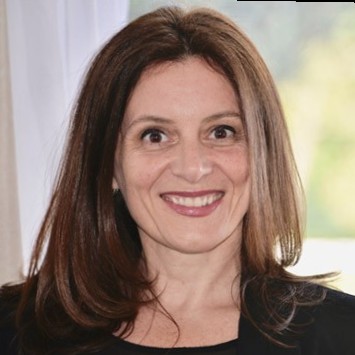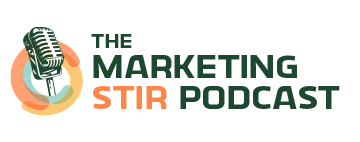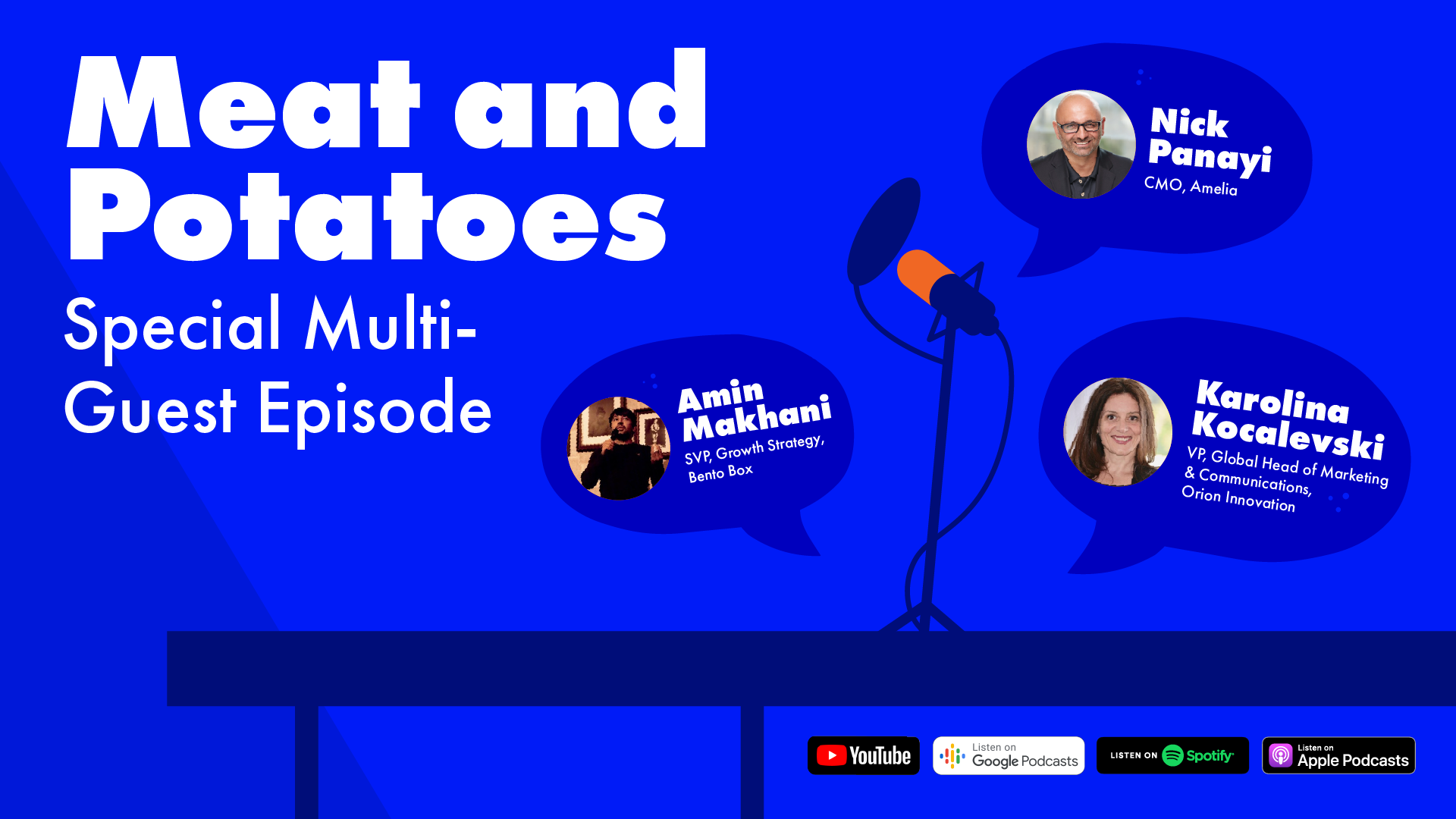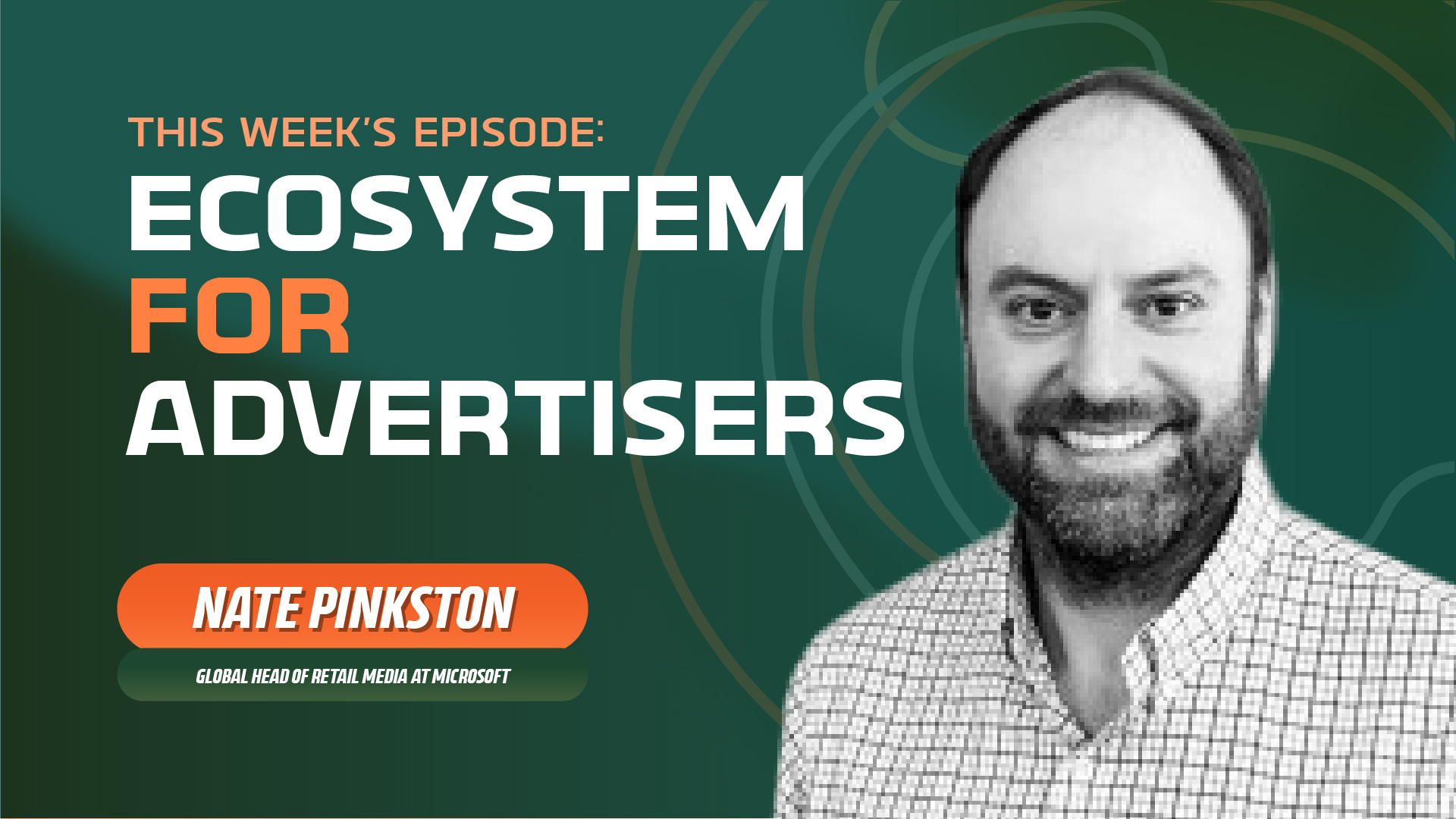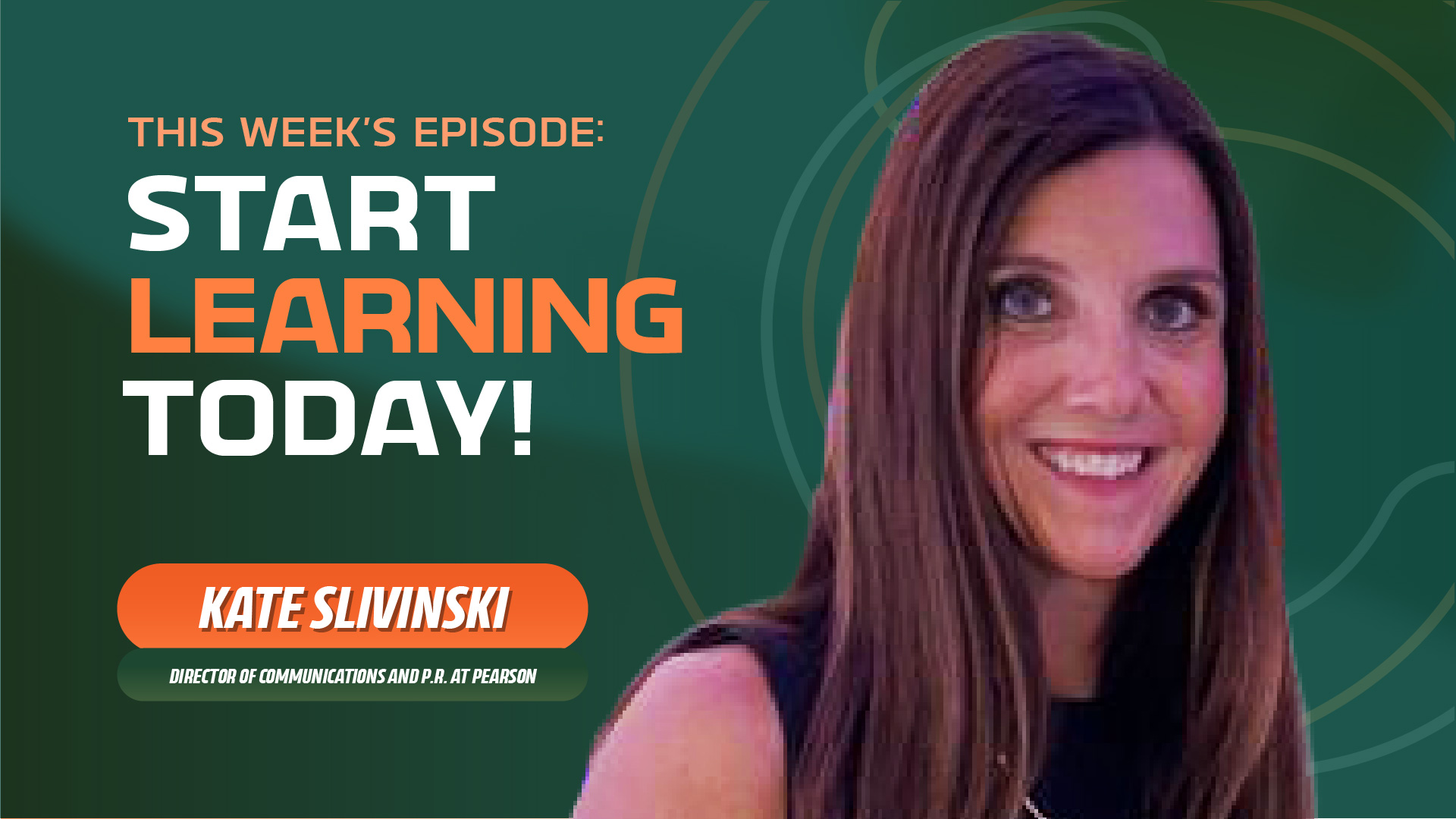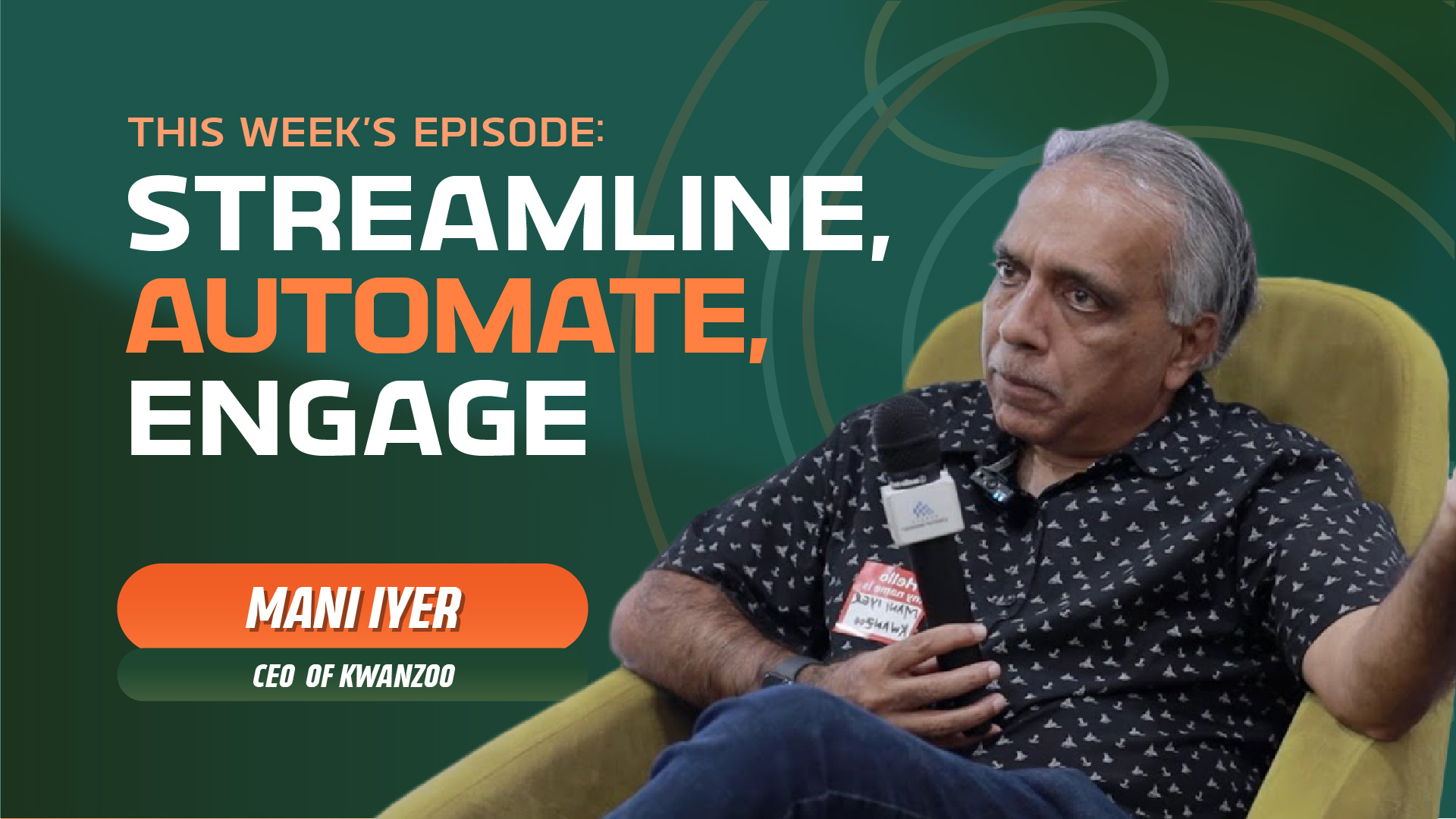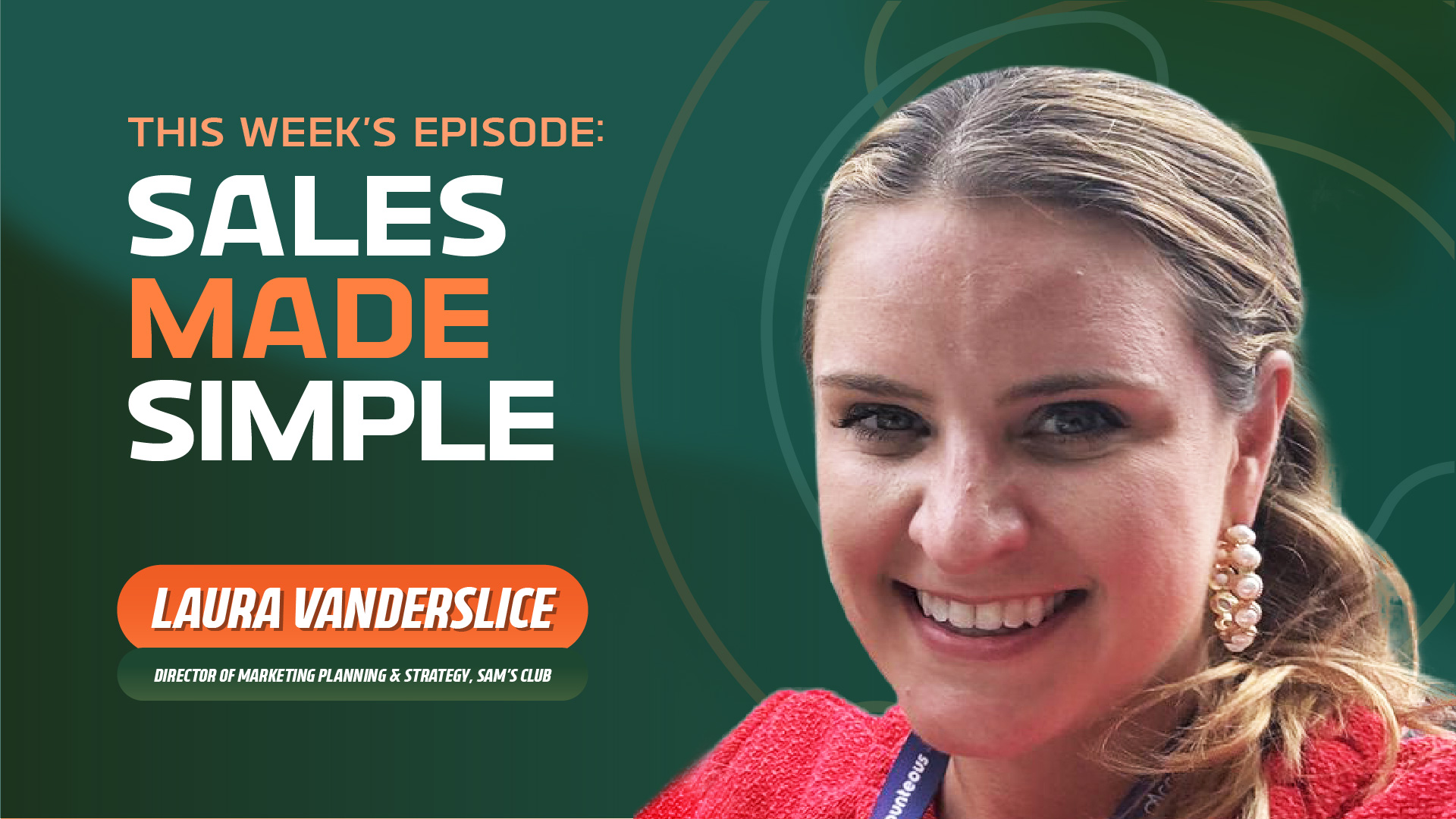Multi-guest - Meat and Potatoes (Special Multi-Guest Episode)
- 0.5
- 1
- 1.25
- 1.5
- 1.75
- 2
Jared Walls: Welcome to the Marketing Stir podcast by Stirista, probably the most entertaining marketing podcast you're going to put in your ears. I'm Jared Walls, associate producer in Stirista's creative copy manager. The goal of this podcast is to chat with industry leaders to get their take on the current challenges of the market, but also have a little fun along the way. In our first multi guest episode, Vincent and Ajay catch up with returning guests Amin Makhani, senior vice president of growth strategy Bento Box, Nick Panayi, CMO at Amelia, and Karolina Kocalevski, VP of global head of marketing communications at Orion Innovation. They discuss innovations on the lead generation front, the biggest changes each organization has undertaken the last year as well as how each guest's role within their own company has shifted. Ajay buys a new laptop, and Vincent is feeling very special. Give it a listen.
Vincent Pietrafesa: Ladies and gentlemen. Hello. It is me Vincent Pietrafesa. What does that mean? Well, it means it's the Marketing Stir, but not the regular Marketing Stir, a very, very special Marketing Stir. This is the first time in the Marketing Stir history, it's been like a year, let me not get carried away here. Right? But in the Marketing Stir history that we are doing a multi guest podcast. Why? Because we've had so many amazing guests on so far, we said, let's bring some of them back and let's focus on a topic that people, you the audience would be interested in. And the first topic is something that I'm very much interested in because of course, I'm the vice president of B2B products and partnerships here at Stirista and that is how the role of marketing and the expectations of B2B marketers are changing. And we have an amazing lineup of guests. I'm going to get to them first. But first you know who's with me? Ladies and gentlemen, my CEO, Mr. Ajay Gupta. What's up Ajay?
Ajay Gupta: Hey, Vincent. To celebrate this occasion, I bought myself a new laptop.
Vincent Pietrafesa: Nice, that's it.
Ajay Gupta: crosstalk in High- Def now.
Vincent Pietrafesa: Come across-
Ajay Gupta: It's time to upgrade.
Vincent Pietrafesa: I love it. I still have the Gateway 1000 that you guys gave me when I started. I'm kidding. But that's awesome. Yeah. How's it working?
Ajay Gupta: So far so good. We'll see how it holds up in the podcast. Yeah.
Vincent Pietrafesa: You'll be all right. It is great to see you. Really quick, here's Stirista, the latest announcement, OMNA. I love that. That just went out. Ladies and gentlemen who are listening, OMNA, it's our new identity graph. You'll see a cool video that just came out, check out our page on LinkedIn or go to our websites Stirista. com. Enough about that. Ajay, we've got a special one today.
Ajay Gupta: Oh, yeah. This is going to be a historic moment for our podcast which is nearing almost a 100 recorded episodes already.
Vincent Pietrafesa: Yes. Recorded and then releasing. We've released over close to 70, we've got a lot recorded. Something tells me we're going to move this one up. No offense to all the other guests out there, but we're going to move this one up. We have three amazing guests, three of my favorite people in this industry. Four, if you count you Ajay, I wouldn't leave you out, but three of my favorite people. Let me just go through first. Ladies and gentlemen first from Bento box, the SVP growth strategy, that's a promotion, sir. Don't think I didn't notice that, we're going to talk about that. Amin Makhani is here. And then also Nick Panayi from Amelia at IPsoft company. You remember that episode? We had so much fun. Oh my goodness. And then my friend, hailing from the Bronx, ladies and gentlemen, Karolina Kocalevski from Orion Innovation. She's the vice president global head of marketing and communications, all in marketing. Nick is the CMO. I forgot to mention that. How dare I? He is the chief marketing officer. Ladies and gentlemen, welcome to a very special episode of the Marketing Stir.
Nick Panayi: Thanks for having us.
Vincent Pietrafesa: So great to-
Amin Makhani: Yeah. Really excited to do this.
Vincent Pietrafesa: It's great to see you all again. It has been for some of us, right? It's been a few months. It's been almost a year, maybe a year, no. I don't think it's been a year. We've talked to a lot of you, but let's start, I want to go to my friend, Karolina. Karolina, and then the rest of the group here, Nick and Amin. For those of you out there who hadn't listened to their individual episodes, I suggest you do. It's excellent, excellent content. I would love for you to give a brief overview of the company and your role for the audience. Let's start with Karolina then let's go to Amin after.
Karolina Kocalevski: Thank you, Vincent. Great to be here. So, yes. I work in the B2B space for a company called Orion Innovation. Orion is a leading digital transformation and product development services firm. We deliver business transformation rooted in digital strategy, experience design and engineering. We've been around for 25 years. So we're quite a mature company, but we've tripled in growth over the last few years. So it's been a real rapid growth story for us. We went from 1400 employees to 5000 employees just in the last couple of years through a very aggressive growth strategy. Our clients are large enterprise clients, mostly across a number of verticals, professional services telecommunications, life sciences, financial services. I joined two years ago as the head of marketing and initially my role was to bring all of the companies that we've been acquiring all under one corporate brand umbrella. During that time we shifted our go to market strategy to a strategy where we're focused on our large verticals, and with that I built a marketing operation where we could grow our existing accounts, bring in new accounts. And having been a small company for a long time, we really didn't have a very big marketing focus. So it's a new function to the company, everything's up for grabs where we're doing things differently and we are targeting into our key verticals now. So the ABM topic perfect for us right now.
Vincent Pietrafesa: That's awesome. I love it. Thank you for that. And Amin, and don't think I didn't notice that promotion, sir, and I love it.
Amin Makhani: Yeah crosstalk.
Vincent Pietrafesa: Come on.
Amin Makhani: Yeah.
Vincent Pietrafesa: Yeah. So, yeah. Tell us about that. Tell us about your new role at Bento Box and tell people out there who are listening about Bento Box.
Amin Makhani: Yeah. First let me talk about Bento Box. Bento box is a software business that focuses on the hospitality industry, restaurants. So it started as websites because restaurants had to either go through an agency where they had no control to get a nice design or they had to do it themselves on Squarespace or Wix, and then it would be very difficult for the website to look nice or for people to access the things they needed or to add events. So it was a platform that where we did it for you, but also you could update it on your own and it's restaurant specific so all of the features were what you wanted and you could update it in an intuitive way. That's how the business got off the ground. But now it's really, our mission is to empower restaurants in their mission of hospitality. So anywhere that we can enlighten the engagement between the restaurant and the diner. So whether that's online ordering, or gift cards, or events management, or making sure the websites are accessible, that they fit through the ADA guidelines. And so all those interactions between the diner and the restaurant is where we want to be, and that's the software. And so that's Bento Box. And then my role, I was running the growth marketing department which is a customer acquisition and also expansion. It's outbound as well. But as of this year, we've hit so many changes to the company, to the team, and I took on a lot of different hats in like driving more orders for our customers which is really more like a productive role, and then also I took on a finance role as we had a gap there. And so as I've been moving around the company in different roles, I think it made, the CEO thought it made sense for me to move more in a role that's like the future, that's the strategy for the future of the business. The business has pivoted a lot last year, how can we keep doing that. And so that's how my role shifted. Also I'm going on a parental leave in about three, four weeks. I have a baby on the way.
Vincent Pietrafesa: Oh, nice. Congratulations.
Amin Makhani: Thank you.
Vincent Pietrafesa: That's awesome. So that's great news all around. That's a crosstalk.
Amin Makhani: By the time this airs I'll have, right? I'll probably have a baby by the time crosstalk.
Vincent Pietrafesa: Yeah, I think, or maybe not. Well, yeah. I think a couple of weeks, so we'll see.
Amin Makhani: Yeah, we'll see.
Vincent Pietrafesa: That's awesome. I love hearing that. And I think about every time I go to my Bobby's, it's a restaurant in New York city, which you live in New York city like me, Amin. I think of you because Bento Box pops up every time I click on it. That is awesome. And then finally my friend, Nick Panayi, chief marketing officer of Amelia. So great to see you again, sir. Tell us a little bit about Amelia as well as your role.
Nick Panayi: Yeah. Thank you, Vincent. Thanks for having me. Great to see you guys again. So Amelia is a conversational AI enterprise software company. Conversational AI for those of you who are not familiar is what the name suggests. It's all about software that knows how people communicate and is able to reflect that same ability to communicate with humans. As you know, humans we're a little messy in our communication style. We change context, we have different accents, and we have, we speak different languages and we change our mind about something and we go back. Machines usually have a hard time understanding that, and that's where conversational AI comes in. So the ability to think and communicate as a human, and then our software then enables action. And also think about the cost center environment where we call them digital employees. So instead of a human employee, you get a digital employee. Ours happens to be called Amelia. And Amelia converses with the customer, understands the intent, which is the most important part. Once she understands the intent, she takes action on behalf of the customer, whether it's canceling a credit card or getting the latest invoice sent to them, and then she closes the loop. Right? So that's just a cost center environment, IT help desk, HR help desk, especially all of us now are being remote. A lot of companies are strained by the need to support more and more remote workers, people who never done VPN before, people who haven't set up their own home office, video cameras and things like that before, they need a lot of help. So it's a technology that's very, very interesting. Again, AI is pretty hot right now. Conversational AI is the space we're in. I've been in the business for almost two years now. And I've come from large companies to small companies, but mostly in technology, mostly in enterprise space or at least in definitely in B2B most of my career. So it's been a blast. We rebranded the company from IPsoft, which was the legacy business to Amelia and looking forward, we have some interesting inflection points ahead of us here in the near future. So next time we'll talk, we'll have some exciting news to share, I believe. So, yeah. Thanks for having me again. Really appreciate it.
Vincent Pietrafesa: Thank you so much all.
Ajay Gupta: All right. Great to see you guys. I go from talking to engineers where I'm the extrovert on the call and then joining Vincent on podcasts where I feel like the biggest introvert. So it's like a hard balance. But one of the challenges in, that most companies are having now is with lead gen. A lot of the traditional sources like in- person conferences have gone away. So sales people around the world seem to be frustrated and others are frustrated with the LinkedIn messages they're getting all of which seem pretty generic. So we'd love to know what you guys are doing for lead gen and we'll start with Amin.
Amin Makhani: Oh, yeah. Sure. I'll go. I want to say something that I think, I don't know how many people follow your podcasts are into the fall search advertising a lot, but there's some really interesting things in search. And this is, I know it's just like meat and potatoes kind of stuff, but in the past it was like search you'd really focus on like certain exact match queries or maybe phrase match queries, and you'd bid on those and you'd get good ROI because you had narrowed set, but search is transforming. Google recently said that 15% of searches every day, they've never seen before. It's a unique search term that has never been searched before, 15% every day. So if you go narrow, you can keep your ROI good, but if you go broad, you might unlock something that you didn't even know was possible in terms of volume. And I think everyone is still catching up to this kind of thing. So if you, and I've been saying kind of, you got to break a few eggs to get an omelet, because you're going to get some wasted spend and you're going to get some bad leads and you're going to get some waste. It is, but it's a process to be able to like really grow your reach, especially at a time like this, where it's sometimes harder the search behavior is changing a lot, search kind of queries are changing a lot. So just take a look at your search. You might find something there that you weren't expecting because of the behavior. Consumer behavior has changed so much in search in the last even three, four years with voice, with mobile just with the length of queries.
Ajay Gupta: And then we'll go over to Nick next.
Nick Panayi: Yeah, it's a great question, and I've learned a lot just by hearing Amin here in the last few minutes. I will tell you, I would reflect the same thing in that, search for us has been the best producer of qualified leads. Let's put it that way. So if the direct question is, what's the most effective tool for us aside from organic traffic, which everyone understands. If somebody comes organically looking for you, you're more likely to get a better qualified lead. The next inaudible tool for us is SEM. But I always caution all of my marketers and my teams to think about cross attribution and cross channel attribution. Marketing is not as simple as that. There is, everything lifts some weight somewhere, whether it's some PR that they've seen before. So when they do a search, they see the name and something triggers in their head, " Oh, I've seen this company before", or the website that's looking better than average so that leaves an impression. So next time they do a search again, they're likely to click on you. Don't forget, I mean, there is always competing dollars for those search terms. So it's not as simple as just buying those terms. You have to do all those other good things that we all need to do, but in terms of pure lead generation, that's the tool that we look to the most.
Ajay Gupta: And then finally, Karolina.
Karolina Kocalevski: Yeah. So we too. I mean, we traditionally hadn't spent a lot on Google search campaigns, but we've gone down that path through the pandemic and it also is yielding some great results for us. Generally, we've been really focused on LinkedIn as our, for us it's a complex sale, it's a solution sale, and we have a lot of followers. We've been growing our followers. A huge tactic in doing that is all the content that we've been putting out, very specific content around digital transformation topics and our webinars. I mentioned that in the last podcast, we're continuing with those. We've rebranded them to Orion Talks now, and so Orion Talks all formats. Now, we're including more clients and prospects and then telling their stories of our transformation. It's really them as the heroes. And we're finding that that kind of content which is a little bit longer form, people are very interested in hearing those stories. So it's been very successful for us and it helps really get us some really good qualified leads beyond what search, I mean, the Google search program has been more around our technology products, our intellectual property where we have something to demo. So we've utilized both strategies for the different types of products and services that we have.
Vincent Pietrafesa: And Karolina, I want to stay with you for a moment there. First I want to let the audience know it's Orion Talks, check out the webinars series. We've heard some from so many podcasts guests, one of the things they did differently over the last year was, well, we started, we did webinars, and normally our webinars used to get like seven people and now they're getting 300 people. And they're having to update the software that they even use their webinars on. So that's been great news. But Karolina, I want to stay with you and talk about, tell the audience the primary targets or industries that Orion Innovation is going after, and has that changed in the last year?
Karolina Kocalevski: Yeah. So our primary industries are professional services, financial services, telecommunications, and life sciences. We have a few others, but there are big, big verticals that some are some big clients and big transformations that are happening in those industries. It hasn't changed, but we have grown, and our domain depth is very strong in those areas. Our client expertise is very strong. So what that's done for us is it's made us focus our messaging just around those verticals, because this is really where we're targeting, this is where we have clients, where we're doing cross selling, our capabilities have grown over the last year. Much as it was a pandemic, our company bought four companies all remotely. So it was very hairy for us. But if anything what it's done is it's focused us on, look, this is where we need to tell our stories as marketers, because this is where the most painful transformations are happening and where industries are really evolving very rapidly and where the pandemic has actually impacted them in how they do their business. So we've been innovating with our clients and creating new intellectual property.
Vincent Pietrafesa: Thank you. And Nick, same question for you. I'd love to understand what targets you go after there, what type of companies that would be able to implement the artificial intelligence and how has that changed over the last year for you?
Nick Panayi: No, it's a great question. And actually that brings up an interesting point. I think in, sometimes companies tend to do well in certain industries at first, and then you get to thinking, well, these are our industry so we focus here. So we try not to do that, right, because there's other industries that we may not have had success yet because we simply haven't tried. So we're careful to kind of balance that, right? But traditionally, again, conversational AI comes in two flavors usually. It's an internal use case in our external use case. Internal use case is either IT help desk or HR help desk or something like that. Every company in every industry has an IT help desk and an HR help desk. So the variable there is really more of one of size, because the bigger your scale, the bigger the value you get out of conversational AI. So that part of it is pretty horizontal. The end user use case, meaning supporting end user customers, that comes in industries that have a lot of customers. So traditionally telecommunication, healthcare, finance, insurance, those have been the industries that have been the first movers in that space, because they have thousands of thousands of customers and therefore the value they get out of putting conversational AI in the cost center, for example, increases exponentially.
Vincent Pietrafesa: Thank you for that. And Amin, now for you, I know restaurants, I feel like restaurants that's something that you don't have to be a B2B marketer, you don't have to be a business professional. I think restaurants have the transformation, the closing down of some, the all of that, that's affected everyone, right? Your local mom and pop shop, larger chains. What have you seen has been like kind of the biggest change in the last year with what restaurants are doing? Talk to me about that.
Amin Makhani: I think there's like specifics in the sense that ghost kitchens or cloud kitchens, or however you call them, the idea that you have a restaurant that doesn't necessarily exist on the ground, they only exist on food delivery sites around the website, and you order from there and you can spin up. I mean, there's a range, right? So there's a restaurant that is like an individual mom and pop that opens a second brand, and the second brand only lives online, has certain foods that are like better for ship delivery and take out. And you kind of function as two separate brands of one parent, right? Then there's like the more, you're one kitchen or two kitchens in two places, and you're 10 brands of 10 different kinds of cuisines and you kind of spin them up and down depending on the interest in velocity of order volume. Like for example, you live in a place that has no Indian food in 30 miles. So you just turn your Italian kitchen into a ghost kitchen that also does Indian food because like, " Oh, Hey, there's a demand for this no one's inaudible. So I think that there's that of like kind of adaptation in general, like restaurants have been adapting more to the needs of the consumer, but there's also just a willingness to embrace technology. And I think that there was a lot of restaurant owners who were kind of anti- technology that they believed that technology took away from the experience between the guest and the restaurant, the diner and the restaurant took away from the hospitality experience. And now you're seeing restaurant owners embrace technology like what technology can I use to solve this problem, which I don't think was something that restaurant owners really, I don't think your average restaurant owner ever approached the problem with like, " What technology will solve this?" And I think that today they're more willing to do so than they were. Partly, some of the older restaurants went out of business, new restaurants replaced, but also I think some of, even the oldest old school restaurant owners have changed their philosophy on this.
Ajay Gupta: inaudible so-
Karolina Kocalevski: crosstalk I can add something. In terms of, I mean much as we're still in the same industries some of the changes we've noticed that are happening with them is that, if I can pick financial services for instance, that has exploded for us. There's been so many changes and things that the financial services industries have had to accommodate for. They have legacy systems and yet the needs of the consumer were to be a lot more digital and the competitive scene changed as well with the new digital players. So we've noticed that there's been a lot of requests for streamlining of systems. The experience design, how are they designing for a better user experience. There's been the digital contactless payments that have all shifted in the last year for our clients. So a lot of technology. They're bringing in also, similar to some of our panelists here in the products and software that they have, they're bringing in bots to eliminate some of these repetitive processes. They're putting in those kinds of technologies help desks. So there's been a lot of activity at financial services firms, for us for our clients and new clients in actually expanding into newer technologies that address a more seamless experience for their customer. So it's been slightly different for us and we do have an experience design group now that really has been exploding in terms of how much we've had to grow them to address these kinds of check shifts that are happening in our clients.
Vincent Pietrafesa: Awesome. Yeah. Thank you for that.
Ajay Gupta: Okay. And then kind of following up on that, so one of the things we see is just B2B selling has changed, right? So because everybody tends to be more or less working from home except for Vincent. But one of, just as an example, we try to encourage our salespeople now to get cell phone numbers. And we see a direct correlation between having somebody's cell phone number to closing deals, just because there's that personal touch and then you get to know your prospects, cats and dogs as they kind of walk around the screen as well. So have there been any changes in terms of how your marketing and sales team is going about with their B2B sales and marketing process as well with people working from home in the pandemic?
Karolina Kocalevski: Yeah. For us, I mean, it's been difficult for our sales guys. They're used to the face- to- face environment and it has been a bit more virtual. But one thing that we've been able to leverage just having large clients is that, every business function has their own technology problems. And once we've done work in one area, we've really had to understand what are the other personas across that massive client, get a referral in. So they've learned to do the virtual selling just through virtue of having someone at that client that we've delivered for and really digging into what's going on in other parts of the business where we could match some some of our expertise and really help them out. So it's the sales process has shifted a little bit from that perspective and really getting on a lot more zones. With marketing, and we were very conscious of the fact that our B2B buyers are actually expecting a sleek experience as well, just like they used to in their own personal lives. So as a consumer. So we've had to borrow things from the B2C world in terms of our own marketing. We use more videos, more compelling snackable content. And so we've been very conscious of that. We were not only selling experienced design services to them and their clients, but we have to make sure that we too are attracting them in the same way and engaging with them in the same way.
Ajay Gupta: I mean, how about you guys? Have you seen any big changes selling into restaurants?
Amin Makhani: Yeah. It's a different thing because it's like the restaurants are still, cell phones always been Holy grail for us because you call the restaurants and the wait staff picks up or whatever. You're not going to get to the owner by calling the restaurant. I mean, you can, it's possible. It's hard though. And so, we've always needed to kind of get cell phone numbers in general. That's a thing. I think sometimes with like larger hospitality groups that have an actual office, they have an office and then they have like, let's say seven to 10 concepts that are restaurants, those ones we used to be able to send stuff to the headquarters, but now like inaudible to the headquarters anymore. So that's like some things unlike the direct mails that stay aside for the groups we have trouble. For the restaurant it's the same, right, because you can just send it to the restaurants someone will get it. And I think that's like, there's some stuff that's, I feel lucky because I know some B2B have been using IP targeting for a while to get to ABM to get to serve at the headquarters using the reverse IP lookups, and we haven't been able to use that because the IP addresses of the restaurants are on those like demand- based databases. So we've never been able successful with those, but now nobody can be successful with those. So I feel a little bit better that, oh, I'm not the only one missing out.
Ajay Gupta: And finally, Nick?
Nick Panayi: Yeah. I'll give you like a bit more of a general answer. The kind of changes that we've seen. I think one of them is, regardless B2B, B2C, is something that Karolina will probably appreciate, is the movement towards digital transformation has accelerated significantly, right? Because the pandemic has caused all of these problems that companies have had to come to the surface. The lack of preparation for digital transformation. So it was before, kind of, oh, maybe we'll get to it when we get to it to where we're going to digitally transform because there's, that's the only way to survive going forward. So we seeing that. What does that mean in buying behavior? Is that we're actually seeing more tolerance for a risk in terms of customers who want to engage, but they want to do it with controlled risks, meaning a pilot or a proof of concept, which again from marketing standpoint is a fantastic thing because gets your foot in the door, right? And then from there, if you have the right sales organization and the right support organization, you can move further. So I think it brings you, it brought us closer to our customers because they're leaning forward a little bit more than they were before. I will say I talked to a number of analyst firms and I sit in on executive councils that we have with customers, they're so focused on customer experience as well. And again, depending on what it is that you market and sell, that is top of mind for them. So for us that plays well into our model because we are all about customer experience through digital employees. But again, what does that mean? Well, it forces them to think about things that they weren't thinking about before. So they're a little bit more open- minded about the cutting edge of things than they were before. Right? So they're more likely to experiment a little bit more. So that's a good thing for marketing, right? So we're able to go straight to, let's just do a pilot. Especially in the SAS world it's, the risk is pretty manageable. So, and the final thing I would say is that the buying committee that we all know about and B2B, the fact that it's not one person or two it's 12, that number continues to grow. Because why? Because all of these things now are really but the company kind of investments that they're making. So they want to have more people involved, more functions when they make some of these technology decisions. So we've seen the buying committee grow even more. I don't know if that's a good thing or a bad thing, but it's a thing. So you got more people to impress.
Vincent Pietrafesa: It's definitely a thing. I know. I see that too on the, because I think just maybe budgets are being looked at carefully or you really looking at different channels and the different dollars that you're putting efforts into. So, yeah. That tends to have more people involved. But I think it's a good thing. I know there's a lot of salespeople out there listening, who are like, " Wait, I want the least path to resistance." It's like, " Well, no, be happy that people are making better I think informed decisions and they're really looking at your, whatever vendor or partner they choose carefully."
Amin Makhani: I think also part of it is like use cases are growing, where like one technology could be used for like not, it came to market with one use case, and now it's like all these can actually use a different bunch of new ways. Even something simple inaudible, we used to be more a marketing product, but then with online ordering, there's a lot of ops component, in- store restaurant ops that are very important in online ordering. And so now it's like whoever's running the restaurant ops is really making this decision as much as the person who's running marketing. And those are two different people. So as you expand the use cases and the functionality and the different, yeah. The buyer's going to grow. It does seem logical kind of.
Vincent Pietrafesa: Mm-hmm (affirmative). Yeah, absolutely. And Amin, I want to stay with you because, we talked about how as a group, how your different customers might've evolved. Right? I would like to talk about, personally within your job or as a company that you saw that you had to pivot this past year. And talk to me about that pivot. This is for the group. I want to start with you first and then how you came out stronger because of it.
Amin Makhani: Sure. Yeah. Well, one, I think that we're very lucky that we were working on an online ordering product that was like comparable same level as the rest of the competitors in the space. And we didn't have to just like spin what, I don't know if you've followed any of the reservations companies, they spun up like online ordering products that were kind of just like hacks based on the reservations and inaudible whatever it's fine. inaudible to do what you do. But we were already in, we launched in February, which was like one month before, and we had a real product in markets. That was great. But I think we used to make, we used to say that everyone needed to get the website for us because that's the front door, and then you can buy the additional products. But once the pandemic hit, some restaurants like, I don't have time to do a new website I just need some ordering software. And so we were able to pivot and start serving a larger group of restaurants that maybe weren't ready to switch websites yet. But I think that what that showed us was that we could solve a lot of problems, individual point problems, point solutions in the restaurant business, and then over time grow that business. But then having that allows us to get to people who maybe aren't thinking of their website brand as important as other customers. So I'm like sometimes you take your thing and you have a vision of what the customer should want and what is best for them and they have a different vision. And when you can find a way to reach more unique types of customers, because you're willing to create a product that's for them, for their vision. I think that that does a lot and that's what we've seen.
Vincent Pietrafesa: Karolina. How about you?
Karolina Kocalevski: We've noticed that companies are more willing to build their own proprietary platforms now. So again, we're in the larger enterprise space and it's often a build versus buy decision that they're making. And somehow in the pandemic, I think echoing what Nick said. There's more of a tolerance to take a bigger bet on how should we really do things. There is a lot to go buy software off the shelf for instance, but, and that's fine. For a lot of purposes, but it won't always give them a 100% of what they're looking for. So there's a small sacrifice that they're willing to have that, that it's not perfect for them. We've noticed that there's more and more enterprises out there willing to build proprietary tech platforms for themselves and that's the business we're into. So it's been a pleasant surprise for us and it just goes to show that everyone is looking to do the right thing from a digital perspective now. It's not necessarily stop gap or we had a pandemic, it has opened their eyes like Nick was saying, and they trying to have a vision for it. How are they going to be serving their clients better, what is the demand, how they're going to keep up with the digital demand. An example would be tax preparers and the professional services space. There's got a lot more aligned clients now than not, so they really need to keep up with the volume, they need to keep up with the scale and will they sacrifice to just buy what's out there or will they build something. So people are investing more and it's been a nice shift that we've noticed as well.
Vincent Pietrafesa: Thank you. Nick, same question for you.
Nick Panayi: Yeah, no, just building on what Karolina was saying, one of the areas that we're seeing within this concept of leaning in and taking more risks, one of the areas that we've seen explode in a good way, and it's a shame that it takes a pandemic, but it is what it is, is how incoming requests are being managed. Right? So call centers traditionally have been designed with a fail over in other regions, meaning, okay, great. So if we overwhelm the us call center will send traffic to India. Well guess what, India is just locked down as we are. And then people are in remote offices or remote locations and they can't get to the same technology that they could before. So you pick your enterprise, you pick your industry, during the pandemic you would call and you would get at least a half an hour wait time before you can talk to anyone. And sometimes two, three hours. That's not a problem. That's like an existential challenge. Problems are one thing to do. This is existential, right? So a lot of customers are now saying, " Okay, now that we're almost out of this thing, how do we rethink this entire customer experience cycle?" So on the front end shore, you can have a digital employee and you can answer the phone immediately, like the technology we have, but then the work that Karolina and her team do on the back end is just as important. Because yeah, sure. You can take in the call faster, but then when you hand it off to the CRM system and the SAP system and the financials and all of that, is that digital transformation in place as well. So we seeing customers who are now willing to take a harder look at their entire customer experience from beginning to end and look for digital transformation there. And I think that's going to be the next two, three years, even more worth of activity. This is not for the faint of heart. This is a significant restructuring of how companies do business. And I think that's, at the end of the day, it's a good thing for consumers, it's a good thing for businesses, but it's going to be two or three years worth of pain for a lot of them to get there.
Ajay Gupta: Nick, a little bit more on the personal side. So has your role changed over the last year personally, and do you think it's a temporary or permanent shift?
Nick Panayi: Yeah, that's a great question. Yeah, it has. I'm not going to bore you too much detail, but I will tell you when I first joined the company, I wanted to be in the office everyday. The office happens to be in New York, I happen to be in Northern Virginia. So that basically meant commuting to New York and then coming home for the weekends. And I did that for a year because I wanted to build that function and build it solid. And the company culturally was very much about in the office kind of setting. Of course, when the pandemic hit and all of a sudden now that whole culture will goes out the door because the whole company now is rethinking the way we do business. So I now do one week in New York, two weeks here to better balance for me, for my family and it's also I think, a productive way to work going forward. And I find that my employees are feeling the same way. I no longer, they no longer feel the pressure to be in the office. So my guidance to them is work from wherever you feel most productive and happiest, right? So if this week means two weeks here, two days in the office, three days at home, great. If next week it means five days at home because of whatever situation you have or they have children or some sort of other situation, great. Because at the end of the day it's the outcome that we should measure, not the process of getting that outcome. So at the end of the day you do fantastic work from the moon, you can work on the moon. I don't really care. So I think a lot of customers, a lot of companies are rethinking that whole mentality. And I think we're going to end up in a better place. We're going to end up in a nice balance and let people work from wherever they feel most productive. So I think that's a positive side effect of an otherwise very bad situation.
Ajay Gupta: Karolina, same question for you.
Karolina Kocalevski: Yeah, sure. So how has the role changed. It definitely has changed. And I don't know that it was necessarily driven by the pandemic. When I was brought in, it was really a big focus on corporate marketing, building a brand, one unified brand, the various parts of our company coming together. And we really celebrated when we got there, new website a new way of engaging with our own clients and telling our story. But what's been the big surprise is that as we shifted our go to market strategy into these cold verticals where we have a lot of clients, we have a lot of deep domain expertise, there's been an explosion in demand for marketing and for ABM marketing. So that has been the surprise. We not only got our story straight from the corporate side, but we're now telling that story to others in those industries. And my own stakeholders, everybody wants a webinar with their clients and their prospects. Everybody wants a video that's very compelling, but short and snackable, but the tale is a compelling story. Video infographics, a lot more help with the targeting that we're doing in that industry vertical. So the demand, so a lot of the corporate marketing, the big work was done there, very, very time- consuming global rollout, but now a very quick rapid shift into ABM marketing, and I think even in inside our company, we've shifted from thinking that marketing is going to bring a lot of leads. We did deliver a lot of leads in that year, but it's very difficult to send people chasing around leads when in reality, we could be a lot more strategic about it, and we can really think about who else can we help that's like this client and where else are these challenges happening and really be a lot more strategic that way. So that's what the account based marketing framework is forcing us to do, take a look at our existing clients, where can we like, our panelists, like Nick was saying, where can we take one use case for a technology we just rolled out. What are other functions possibly at that company that we can augment those products a little bit and use it and roll it out there. So that's the kind of strategic thinking we've had to do around who our clients are, who are other target prospects and what kind of marketing and messages can we create so that it makes it easier for them to understand what we can do for them. So huge explosion on the IBM side, we're really just peddling super fast to keep up with all of our stakeholders, and it's been a nice shift for us.
Ajay Gupta: And Amin, finally for you, I know, stand up comedy has been affected inaudible.
Amin Makhani: Yeah, mate. You know what's funny is I was going to quit the game like two weeks before the pandemic and then the pandemic quit me. So I didn't. I think the Open Mic might be back. Mics back? Do you know?
Vincent Pietrafesa: I don't know. My first live performance is May 1st. So this will probably air from that but-
Amin Makhani: Where is it?
Vincent Pietrafesa: I'll be at Greenwich Village Comedy Club.
Amin Makhani: Oh, sure. Yeah.
Vincent Pietrafesa: Or Grisly Pear Comedy Club too, yeah.
Amin Makhani: Yeah. Nice. Yeah. I think I'm starting to get emails from people being like, I'd like to do the mic on Tuesday and I'm like, crosstalk.
Vincent Pietrafesa: Yeah, it's like mic. Yeah, no.
Amin Makhani: Yeah. crosstalk.
Vincent Pietrafesa: I don't think comedy clubs are going to open just for the mics.
Amin Makhani: I don't think they're going to open for the mics, but maybe. Yeah. So there's that, but no. This is like more kind of a macro thing and I don't know what, I don't know how it's going to look for long- term, but there is like, and we're seen as both our customers, but also at our own business, it's just kind of like labor shortages, where there is a lot of, especially in tech, there's a lot of fast growing companies that are just swapping up salespeople and marketers and tech and engineers and product people and even G& A folks. And so, I think that there is a little bit more like if you're at a fast growing company, even more than before, you might have to wear a couple hats more than you used to have to wear. And that's what's happened to me, and I think that, I think one thing that's good about that is that, at least for marketers if you end up doing it, like I'm doing some finance work, which is probably not exactly common. But so, I can kind of bring that lens to marketing about ROI on marketing spend that they don't kind of look, they might look at a channel basis like, " Oh, this channel is not performing what I need", but like, " Well, if you turned it off, everything would come down." The other channels would perform worse. And so like, we can run that experiment, but if you're ready for the revenue risks to it. And I think that framing that has allowed it to be a more interactive conversation, rather than like you got to turn this stuff off because it's not performing, because... And then you were like, " Yeah, we can turn off. We'll prove if it does stuff." And I think that my role has expanded based on kind of missing gaps of the company, but I think that's going to happen a lot over the next handful of years as the economy goes a little bit faster than jobs are available, a little bit faster than people have the skills to fill all the jobs that are needed probably over the next couple of years, especially in these inaudible. So you read a thing, every day you read a company raised$ 200 million. It's like it's turning into a kind of a very common occurrence and they're going to deploy that money. So I think that's going to happen a lot.
Vincent Pietrafesa: No, I appreciate all those thoughts. And then, we're almost out of time. That's how, what happens when you get great people together and people that we know and friends. So let me just go around. Quick questions, ABM, Nick, I always think of you when I ABM, it's because of our past conversations on it. Can you touch a little bit about what you think kind of the future of ABM is going to look like?
Nick Panayi: Yeah. Absolutely. Now, I'll build up on something that I'm in just so because I think it's very important. I think marketers in general are like doctors, right? So a doctor doesn't go into their specialty before they understand how the rest of the body works. So it's the same thing with marketers. They need to have that kind of general understanding of all the functions frankly, in marketing and around the rest of the business before the focus on the specialization. So ABM is one of those functions, right? You don't throw just an average marketer in ABM. ABM is for the stars. So the ones that have potential, the ones that understand how to work with sales, they ones that understand how marketing works in general, they become maybe [ABM-rist 00:49:35] because the ABM are supposed to be a mini CMO as we talked about, right? For you to be the conduit between the sales team and the marketplace, you need to be a mini CMO. You can't just be a single track marketer. So that's number one. Number two, I believe very strongly that the best instance of ABM is truly a single account, right? So one of the things that has become an interesting discussion point when I talk to marketers is, some people use ABM as a general term to discuss segment marketing, like five accounts, 10 accounts. Well guess what, it's 10 of them. It's not one. So they're not alike even if they're in the same zip code, the same industry, the same size, they're not alike. ABM is one- on- one. So to that end, I believe strongly that pursuit marketing is a subset of ABM discipline that is going to continue to gain a lot of traction with pursuit meaning your strategic deals. Why? Because that's when sales pays most attention. Sales pays most attention when the persona wallet is being impacted. And if that quarter or that year is on the line because of that big deal that you're about to go close, you're going to pay a lot more attention to the ABM or who's working with you to help you close and penetrate that deal. So I think pursued marketing as a subset of ABM is going to continue to pick up speed. But overall ABM is just one of those areas you simply can't ignore anymore. It's going to be more and more an area that people invest in.
Ajay Gupta: Karolina, final question for you. What are some of the trends you think are happening in B2B as we go into 2022?
Karolina Kocalevski: Yeah. I think what we're hoping for anyway is that, we're seeing better technology come out. A lot of the technology has been exploding in the space and it's been difficult to kind of know what really could we be using. I think that some of the promise of the technology in marketing falls a little short but that's where I think that the next generation of tech that comes out for the space is really going to help us have a more of a 360 ° view of our own B2B clients, know more about them, understand those personas so that when we do these one- to- one account based marketing programs for that account, we really understand who the players are at that account, and really what is important to them. Because we don't have, none of us have perfect information. We understand a little bit by aligning with our sales teams and seeing what they know but the rest, what can technology do for us. And I think that we're seeing better stuff come out, and I think that's the future. I think when someone really creates technology that can really help us understand these potential clients and prospects from a personal persona perspective, we'll come far. So we're looking forward to that.
Vincent Pietrafesa: Thank you. And Amin, just quickly about some of the, you think future trends for the restaurant industry.
Amin Makhani: Oh, yeah, man. Yeah. I think that this is something that, I mean, I don't know, we'll see how it works, but I think that, I think you'll see some of the contact lists, some of the menu stuff, the QR code payments. I think you'll see some adoption of that post COVID not for health and safety, but for capturing email addresses and marketing and loyalty programs. And right now you're seeing some companies like Wingstop and Chipotle that are just doing phenomenal things with marketing technology that is just ahead of the game and they're getting 50, 60, 70% of their orders online and they're building more loyal customers and they can get them to come back with app notifications. And your little mom and pops can't do all of that yet, but they can partner with technology firms to get closer. And I think that you're going to see that in the next year or two, is that if people think about, " Oh, we used this in the pandemic for pandemic reasons", but now we can use them for business reasons unrelated to the pandemic.
Vincent Pietrafesa: I appreciate it. And I just want to thank the three of you for joining us on the first of our multi guest series. This has been absolutely amazing. I can't wait until, there's a week when Nick you're here in New York, Karolina comes down from the Bronx, Amin comes in from Brooklyn and we all can get together. And this has just been amazing. I truly want to thank you. Ladies and gentlemen, these guests, again, Amin Makhani from Bento Box, Nick Panayi from Amelia, Karolina Kocalevski from Orion Innovation. I'm Vincent Pietrafesa, that's Ajay Gupta. This is the Marketing Stir. Thank you so much for listening and watching. We'll see you soon.
Jared Walls: Thanks for listening to the Marketing Stir podcast by Stirista. Please like rate and subscribe. If you're interested in being a guest on the podcast, email us @ infoatthemarketingstir. com. Thanks for listening.
DESCRIPTION
This week we are joined by Amin Makhani (SVP, Growth Strategy, Bento Box); Nick Panayi (CMO, Amelia); and Karolina Kocalevski (VP, Global Head of Marketing & Communications, Orion Innovation) to discuss innovations on the lead generation front, the biggest changes each organization has undertaken in the last year, as well as how each guest’s role within their own company has shifted. Ajay buys a new laptop, and Vincent is feeling very special.
Today's Host
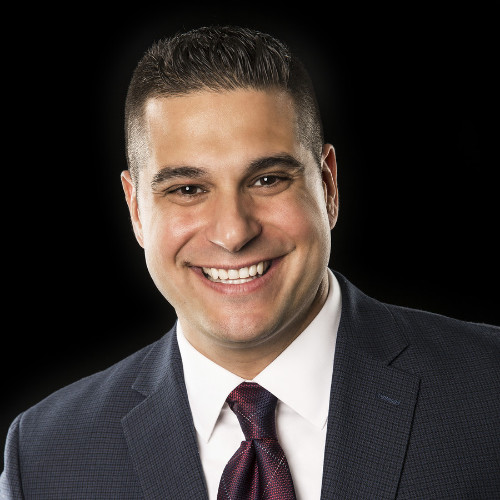
Vincent Pietrafesa
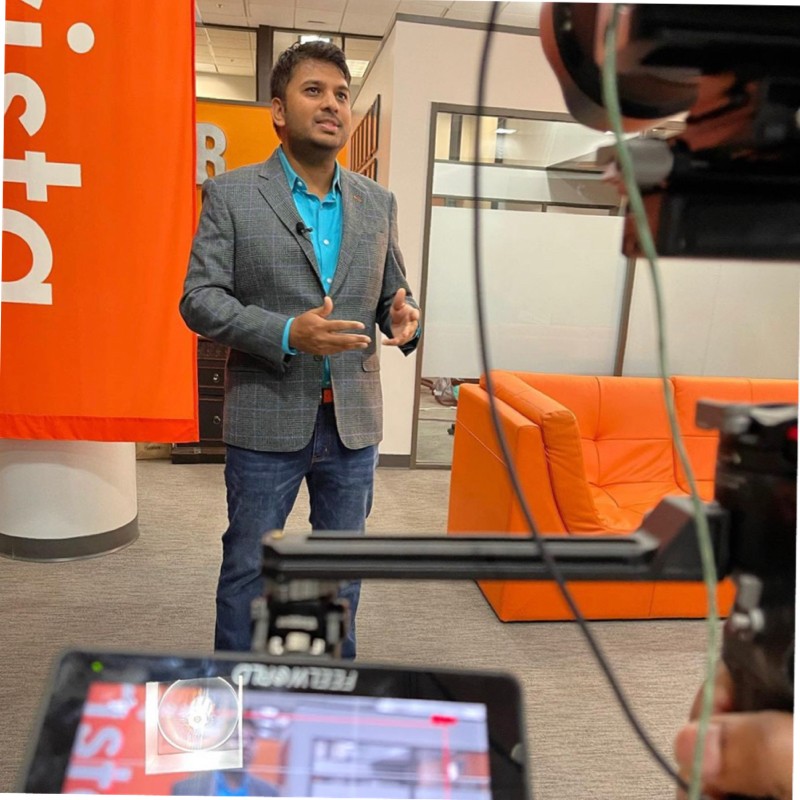
Ajay Gupta
Today's Guests
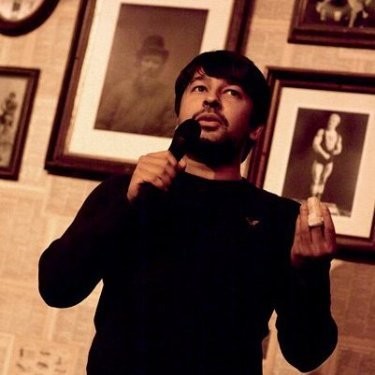
Amin Makhani
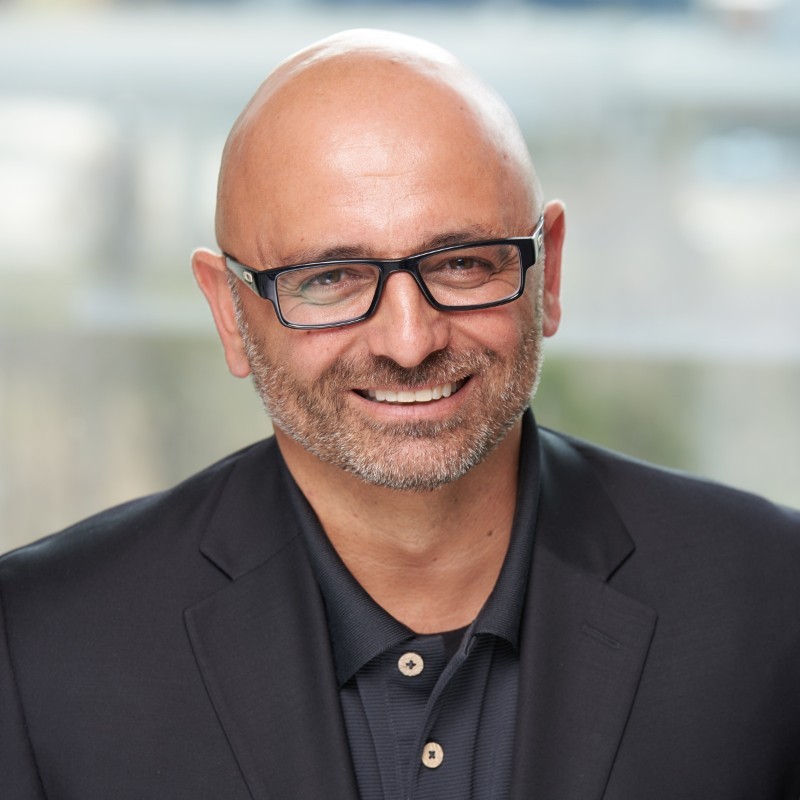
Nick Panayi
